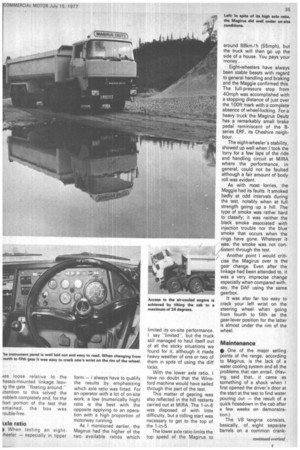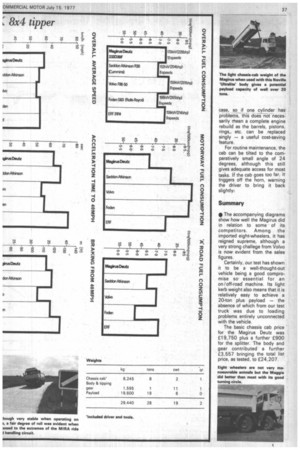Maggie has a modest thirst
Page 36

Page 37

Page 39

If you've noticed an error in this article please click here to report it so we can fix it.
But take care when choosing her gear options, says Graham Montgomerie Photos by Steve Back
THE UK EIGHT-WHEELER market is very congested with eight manufacturers .competing for a share of fewer than 2,000 chassis per year.
Although traditionally a British market, the past few years have seen a number of Continental factories join in the competition with the German company, Magirus Deutz, first off the mark.
Our latest CM operational trial features the Magirus eight-legger — or the 232 D30 FK as it is officially known — which gave an extremely good account of itself, although we had some niggling problems.
Aiming at the tipper market in particular, Magirus Deutz (Great Britain) Ltd offers only one wheelbase, which at 5.64m (18ft 6in) first axle to mid-bogie, is the shortest from the German factory commensurate with a full 30 tons gvw. Not so long ago, the Magirus was unique on two counts — it featured an air-cooled engine and it was assembled over here. Now, only the first is true as Volvo assembles certain models over here, while Magirus has stopped, preferring to import the complete chassis fully assembled.
Engine and transmission
• The engine is a V8 design, part of a modular series which also includes the 230kW (310bhp) V10 fitted in the top-weight tractive unit. Maximum power is in the region of 170kW (228bhp) which is certainly adequate for an eight-wheeler, although the maximum torque of 722Nm (530Ibft) is on the low side.
As with the identicallypowered FS tractive unit, a six-speed constant-mesh ZF gearbox is fitted with the option of a front-mounted splitter giving 12 forward ratios.
Although it seems a fairly exotic specification for an eight-wheeler, nearly half of the Magirus orders opt for the splitter, so our test truck was fitted with the option. It gave a useful benefit on the road section of our operational trial, t but operators will need to look at their own needs very carefully to justify the £900 extra for the splitter.
Rounding off the transmission specification are the Magirus Deutz hub-reduction axles. Our test truck was fitted with the higher of the two ratios offered by Magirus GB and this must be remembered when considering the fuel consumption we achieved and also when checking the gradeability and on-site performance.
Economy • With an overall fuel consumption figure of 38.7 fit/100km (7.3mpg) for the CM Midlands test route, the Maggie is right up with the best of them on this vital aspect of performance.
The individual stage results were a little, confusing, however. With the very long overall top gear ratio — it gave a maximum speed of 113km / h (70mph) I would have expected a good fuel consumption figure on the motorway compared with the A-road section where it might be slightly overgeared. In fact, the reverse occurred.
On the M1 /M45, the Magirus recorded 41.4 lit/100km (6.8mpg), which, although reasonably satisfactory, is not outstanding. But the rest of the test, off the motorway, was covered at an average consumption of 37.7 lit/100km (7.5mpg) — a much better performance. The accompanying diagrams show how the Maggie performed in relation to four o its major competitors.
The final fuel figure woulc have been even better if we hac not had problems with th( gear change on our test vehicle The Maggie uses the ZF six speed box as fitted to MAN Saviem and OAF but, on thil test, the unit was not its usua quick-changing self. It was no so much a case of crunching thE gears as not being able to finc the slot at all which necessitat ed two or even three stabs at i to find a ratio.
As the sand quarry we wer( using to test the on-site perfor mance was near to Magirw Deutz GB's Winsford base, w( nipped into the workshops tc see if anything could 13( done. What had happened, ir fact, was the cab-mounted level was loose relative to the hassis-mounted linkage leavrig the gate "floating around." Ittention to this solved the roblem completely and, for the hort portion of the test that e.mained, the box was rouble-free
kxle ratio
When testing an eight/heeler -especially in tipper form -I always have to qualify the results by emphasizing which axle ratio was fitted. For an operator with a lot of on-site work, a low (numerically high) ratio is the best with the opposite applying to an operation with a high proportion of motorway running.
As I mentioned earlier, the Magirus had the higher of the two available ratios which
limited its on-site performance. I say "limited-, but the truck still managed to haul itself out of all the sticky situations we found for it, although it made heavy weather of one or two of them in spite of using the diff locks.
With the lower axle ratio, I have no doubt that the Winsford machine would have sailed through this part of the test.
This matter of gearing was also reflected in the hill restarts carried out at MIRA. The 1-in-6 was disposed of with little difficulty, but a rolling start was necessary to get to the top of the 1-in-5.
The lower axle ratio limits the top speed of the Magirus to around 88km / h (55mph), but the truck will then go up the side of a house. You pays your money . . .
Eight-wheelers have always been stable beasts with regard to general handling and braking and the Maggie confirmed this. The full-pressure stop from 40mph was accomplished *with a stopping distance of just over the 100ft mark with a complete absence of wheel-locking. For a heavy truck the Magirus Deutz has a remarkably small brake pedal reminiscent of the Bseries ERF, its Cheshire neighbour.
The eight-wheeler's stability, showed up well when I took the lorry for a few laps of the ride and handling circuit at MIRA where the performance, in general, could not be faulted although a fair amount of body roll was evident, As with most lorries, the Maggie had its faults. It smoked badly at odd intervals during the test, notably when at full strength going up a hill. The type of smoke was rather hard to classify; it was neither the black smoke associated with injection trouble nor the blue smoke that occurs when the rings have gone. Whatever it was, the smoke was not conistent through the test.
Another point I would criticise the Magirus over is the gear change. Even after the linkage had been attended to, it was a very imprecise change especially when compared with, say, the DAF using the same gearbox.
It was also far too easy to crack your left wrist on the steering wheel when going from fourth to fifth as the gear-lever position for the latter is almost under the rim of the wheel.
Maintenance
• One of the major selling points of the range, according to Magirus, is the lack of a water cooling system and all the problems that can entail. (Having said that, it came as something of a shock when I first opened the driver's door at the start at the test to find water pouring out — the result of a quick hosedown in the cab after a few weeks on demonstration) The V8 tengine consists, basically, -of eight separate barrels on a common crank
case, so if one cylinder has problems, this does not necessarily mean a complete engine rebuild as the barrels, pistons, rings,. etc. can be replaced singly — a useful cost-saving feature.
For routine maintenance, the cab can be tilted to the comparatively small angle of 24 degrees, although this still gives adequate access for most tasks. If the cab goes too far, it triggers off the horn, warning the driver to bring it back slightly;
Summary
• The accompanying diagrams show how well the Magirus did in relation to some of its competitors. Among the imported eight-wheelers, it has reigned supreme, although a very strong challege from Volvo is now evident from the sales figures.
Certainly, our test has shown it to be a well-thought-out vehicle being a good compromise so' essential for an on/off-road machine. Its light kerb weight also means that it is relatively easy to achieve a 20-ton plus payload — the absence of which from our test truck was due to loading problems entirely unconnected with the vehicle.
The basic chassis cab price for the Magirus Deutz was £19,750 plus a further £900 for the splitter. The body and gear contributed a further £3,557 bringing the total list. price, as tested, to £24,207.




























































































